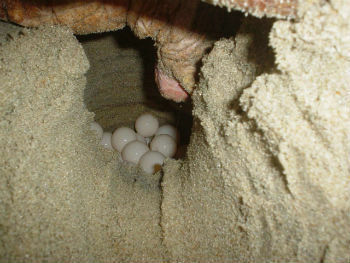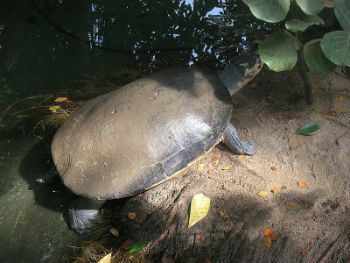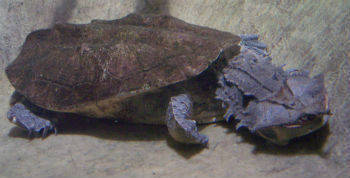The turtles or testudines are reptiles of the Chelonia Order. There are believed to be about 335 species of turtles worldwide. They are found in marine, freshwater and terrestrial environments.
Turtles, tortoises and tortoises represent the turtles. Turtles live in fresh and salt water environment. Tortoises are found in fresh water and tortoises on dry land.
Features
The main characteristic of turtles is their bony armor, the shell or carapace. This structure provides protection to the body against mechanical shock and predator attacks.
The hull is located in a dorsal position. In the ventral position is the plastron. The spinal vertebrae and ribs fuse with the hoof. All these elements form a rigid bone box, covered with keratin plates.
Chelonians don't have teeth. Instead, they have a kind of beak with horny blades, allowing them to capture and cut food.
The diet is diverse and varies according to the species:
- Marine species are exclusively carnivorous, they feed on molluscs and crabs.
- Freshwater species feed on fish, fruits, molluscs and insects.
- Terrestrial species are herbivores.
In the food chain, turtles are consumed by alligators, large fish, mammals and birds.
Chelonians have lung respiration and a closed circulatory system.
reproduction
Reproduction is sexual, the male transfers sperm into the female's body.
For being oviparous animals, females look for a place to lay their eggs. The number of eggs varies from species to species. Exclusively aquatic species only surface at that moment. Some have to travel several kilometers to reach the coast.
Eggs are laid in nests dug in the ground or sand. The determination of sex can be genetic or by the incubation temperature of the place where the eggs were laid. Higher temperatures determine the appearance of female individuals.

nest with turtle eggs
When the little turtles are born, they go towards the sea and do not need to be cared for by their parents.
Species found in Brazil
The main species of turtles found in Brazil are:
Sea turtles
THE loggerhead turtle (caretta caretta) is the most common marine species in Brazil. Its name is due to the size of the head being larger than that of other species. It occurs in tropical, subtropical and temperate seas around the world. It is an endangered species.
THE hawksbill (Eretmochelys imbricata) is found in tropical seas. It got its name because its hull was used to make combs. Its size can exceed 1 m in length and weigh more than 150 kg. It is a critically endangered species.
THE leather turtle (Dermochelys coriacea) is the largest species of sea turtle. She lives most of the time in the oceanic zone and only comes to the coast during the breeding season. It is an endangered species.
THE olive turtle (Lepidochelys olivacea) is the smallest among all species of sea turtles. It measures up to 60 cm and weighs around 65 kg. It receives this name for presenting a greenish color. It is found in tropical and subtropical seas. It is a species vulnerable to extinction.
Amazon Chelonians
THE Amazon it is the Brazilian biome with the largest number of turtle species, many of which are at risk of extinction. This fact is due to hunting and the consumption of animals for food. The meat of some turtles is highly appreciated in Amazonian communities, especially the Amazonian turtle and the tracajá.
Some species of Amazonian turtles are:
THE Amazon turtle (Podocnemis expands) is the largest freshwater species in the world. It can reach 90 cm in length and weigh up to 65 kg. It is a critically endangered species.

Amazon turtle
O tracaja (Podocnemis unifilis) is a common species in the Amazon. It reaches up to 50 cm in length and weighs around 12.5 kg. Currently, it is threatened with extinction.
O iaca (Podocnemis sextuberculata) reaches up to 34 cm and 3.5 kg. Its main feature is the convex hull.
O irapuca (Podocnemis erythrocephala) is the smallest of all species, reaching up to 32 cm. The species is recognized by the presence of a red color on the head.
THE kill Kill (chelus fimbriata) is a species of tortoise, with a triangular-shaped head and carapace, which gives it a unique and favorable appearance. camouflage. Your nose is long and pointed. It can measure up to 45 cm.

Kill Kill
Learn more about reptiles.


